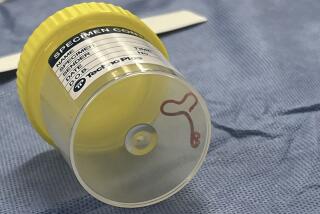Last turn of the Guinea worm?
- Share via
A “fiery serpent” that plagued the Israelites in the Old Testament and that’s been found in Egyptian mummies continues to afflict tens of thousands of people today. The ancient parasitic sickness, known as Guinea worm disease, can still be cured only with an ancient remedy. But experts say the disease is on the verge of becoming ancient history, despite its age-old persistence and the lack of advances in medical treatments.
---
Just half a century ago, tens of millions of people were affected by the painful and debilitating Guinea worm infection. Europeans dubbed the worm Dracunculus medinensis, or “Medina vein,” for the holy Middle Eastern city once plagued by the parasitic disease. The Arabic word for the disease translates as Pharaoh’s worm, harking back to the malady’s first documentation several thousand years ago in Egypt.
But despite being observed for millennia, Guinea worm disease has proved tricky to defeat. The problem was long a misunderstanding: The worm itself, which grows up to 3 feet inside the human body and emerges through a festering blister on the leg, was mistaken for a rotting vein.
When medieval doctors finally concluded that it was, in fact, a worm, they thought people got it from walking barefoot, wading in dirty water or being exposed to sick neighbors.
In the 1870s, Russian explorer and scientist Aleksej Fedchenko determined (to much scientific dissent) that ingesting a water flea was to blame. Guinea worm larvae, Fedchenko said, resided within microscopic, one-eyed water organisms called Cyclops. People who unwittingly drank Cyclops, he posited, became infected.
Fedchenko struggled to validate his theory by feeding flea-ridden water to cats and dogs. The pets resisted infection, however, and Fedchenko died in an Alpine climbing accident before ever proving his point.
Picking up where Fedchenko left off, English scientist Robert Thomas Leiper successfully infected a monkey by feeding it Cyclops-tainted bananas. But when Indian scientist Dyneshvar Atmaran Turkhud attempted to replicate the experiment a few years later, he failed.
Turkhud succeeded, however, in infecting humans. He persuaded five “volunteers” to drink water containing Guinea-worm-infected Cyclops. One year later he observed blisters in one of them, his lab assistant, proving the parasite’s transmission cycle.
But even that information failed to yield a medical cure. Drugs that kill the worms cause serious complications, so the treatment remains an ancient Egyptian one: wait for the worm to emerge through the blister and then pull her (the infecting worm is always female) out gently, winding her slowly around a stick to avoid breaking her fragile body.
The ancient Egyptians were not always so patient. In the 1970s, researchers discovered traces of a Guinea worm still intact inside a teenage mummy with prosthetic legs. Archeologists concluded her limbs had been amputated in efforts to cure a stubborn worm infection.
Though tens of thousands of people are still afflicted by the worm today, experts expect the disease to go the way of smallpox (that is, to be wiped off the planet) by 2009. An international campaign has brought infection rates down 99%; most remaining cases are in Sudan, where civil war has slowed progress.
The disease (which causes pain, blistering and difficulty walking) has so far been eradicated largely by cleaning up water and educating people on how it’s spread. Dealing with it once it’s been contracted is another matter. When it comes to curing cases, even the world’s top Guinea worm specialists must resort to the age-old technique: wrapping emergent worms around sticks, slowly and ever so carefully.
Elena Conis
More to Read
Sign up for Essential California
The most important California stories and recommendations in your inbox every morning.
You may occasionally receive promotional content from the Los Angeles Times.













